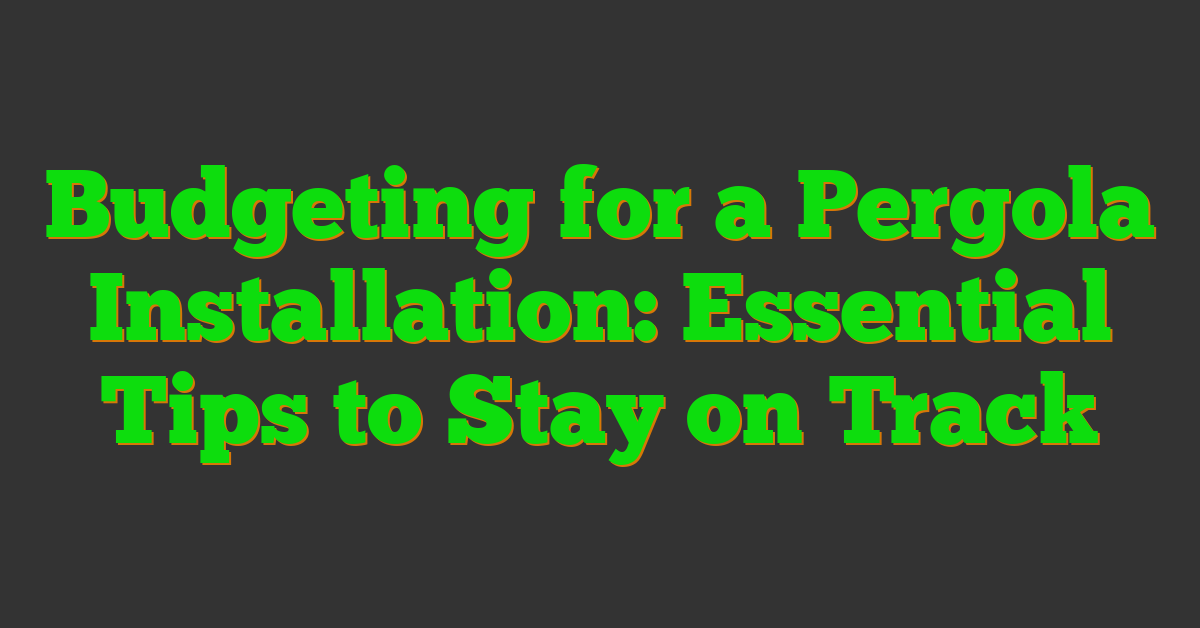Are you dreaming of adding a cozy pergola to your backyard but worried about the costs? I’ve been there, and budgeting for a pergola installation can feel overwhelming at first. But with a little planning, you can create a beautiful outdoor space without breaking the bank.

In this article, I’ll walk you through the essential steps to budget effectively for your pergola project. From selecting materials to understanding labor costs, we’ll cover everything you need to know to make informed decisions and achieve the pergola of your dreams.
Planning Your Pergola Installation
First, assess your outdoor space to determine the ideal pergola placement. Measure the area accurately to ensure the pergola complements your backyard layout. Consider the sun exposure and existing structures to maximize functionality and aesthetics.
Next, select materials based on durability and budget constraints. Popular options include wood, vinyl, and metal. Wood offers a natural look, vinyl provides low maintenance, and metal ensures longevity. Each material has distinct cost implications, so choose one that balances quality and affordability.
Define the pergola size and design to fit your space and meet your needs. Determine the height, width, and length that align with your outdoor activities. A larger pergola may accommodate seating areas, while a smaller one provides shade for dining spaces. Customize the design with features like built-in lighting or retractable canopies to enhance usability.
Estimate labor costs by obtaining quotes from multiple contractors. Labor expenses can vary based on complexity and location, so compare estimates to find the best value. Ensure contractors are licensed and insured to avoid unforeseen expenses.
Finally, acquire necessary permits by checking local regulations. Permit requirements differ by area, so contact your local building department for guidelines. Securing permits beforehand prevents delays and ensures compliance with building codes.
Understanding Pergola Costs
When budgeting for a pergola installation, it’s crucial to consider all associated expenses. This section breaks down the primary cost factors to help you plan effectively.
Material Expenses
Material costs vary based on the type and quality of the pergola. Here’s a breakdown:
- Wood: Offers a natural aesthetic. Typically ranges from $15 to $35 per square foot.
- Vinyl: Requires low maintenance. Costs usually fall between $20 and $40 per square foot.
- Metal: Provides durability and a modern look. Prices generally run from $25 to $50 per square foot.
| Material | Cost per Square Foot |
|---|---|
| Wood | $15 – $35 |
| Vinyl | $20 – $40 |
| Metal | $25 – $50 |
Choosing the right material depends on your budget, desired maintenance level, and preferred style.
Labor Costs
Labor expenses can significantly impact your overall budget. Factors influencing labor costs include:
- Installation Complexity: Simple designs cost less, typically between $500 and $2,500.
- Location: Urban areas may have higher labor rates, averaging $50 to $100 per hour.
- Contractor Experience: Experienced contractors might charge premium rates, ranging from $70 to $120 per hour.
Obtaining multiple quotes ensures you receive a competitive price while hiring qualified professionals.
Setting a Realistic Budget
Determining a realistic budget ensures your pergola project stays on track. Start by calculating the total cost, including materials, labor, permits, and additional features. For example, material costs range from $15 to $50 per square foot, depending on the type. Labor typically accounts for 30% to 50% of the total budget.
| Cost Component | Estimated Range |
|---|---|
| Materials | $15 – $50 per square foot |
| Labor | 30% – 50% of total cost |
| Permits | $50 – $200 |
| Additional Features | $100 – $500 |
Factor in permits, which vary by location, generally costing between $50 and $200. Obtain multiple contractor quotes to compare prices and services. Allocate funds for unexpected expenses, such as structural adjustments or design changes, typically adding 10% to the budget.
Prioritize essential elements like pergola size and material quality. Optional features, such as lighting or integrated seating, can be included based on available funds. By outlining each cost category and planning for contingencies, you set a clear and achievable budget for your pergola installation.
Cost-Saving Strategies
Implementing cost-saving strategies can significantly reduce the overall expense of installing a pergola. By carefully planning and making informed decisions, I manage to stay within my budget without compromising quality.
Choose Economical Materials
Selecting the right materials is crucial for cost efficiency. Opting for vinyl pergolas typically costs between $20 to $40 per square foot, which is more affordable than metal options priced at $25 to $50 per square foot. Wood pergolas, ranging from $15 to $35 per square foot, offer a balance between cost and aesthetic appeal.
Simplify the Design
A straightforward design minimizes both material and labor costs. I focus on rectangular shapes instead of complex geometries, reducing the amount of lumber and simplifying the construction process. This approach not only lowers expenses but also shortens the installation time.
DIY Where Possible
Taking on certain tasks myself can lead to substantial savings. I handle painting and staining the pergola, which saves approximately $200 to $500 in labor costs. Additionally, assembling pre-cut materials reduces the need for specialized tools and professional assistance.
« Best Shovels for Digging in Your Yard: Top Picks & Ultimate Buying Guide How to Plant a Herb Spiral: Step-by-Step Guide for a Thriving Garden »
Shop for Discounts and Sales
Purchasing materials during sales or using discount codes helps lower costs. I regularly check home improvement stores for promotions, allowing me to purchase high-quality materials at reduced prices. This strategy can save up to 15% on total material expenses.
Repurpose Existing Materials
Reusing materials from existing structures cuts down the need for new purchases. I utilize leftover lumber from previous projects, which reduces material costs by about $100. Ensuring the reused materials meet safety and quality standards is essential for durability.
Obtain Multiple Quotes
Obtaining quotes from several contractors ensures competitive pricing. I request at least three quotes to compare services and costs, which helps me negotiate better rates and choose the most cost-effective option without sacrificing quality.
Plan for Seasonal Installation
Scheduling the installation during off-peak seasons can result in lower labor costs. Contractors often offer discounts during winter months, saving me approximately 10% on labor expenses. Planning ahead ensures availability and cost savings.
Utilize Permits Wisely
Acquiring the necessary permits prevents costly delays and fines. I ensure all paperwork is completed accurately, avoiding additional fees and ensuring a smooth installation process. Budgeting $50 to $200 for permits is a wise investment to avoid unexpected expenses.
By applying these cost-saving strategies, I maintain a balanced budget for my pergola installation, achieving a beautiful outdoor space without overspending.
Selecting the Right Contractor
Choosing the right contractor ensures your pergola installation stays on budget and meets quality standards. I evaluate contractors based on the following criteria:
- Verify Licensing and Insurance
I verify that the contractor holds the necessary licenses and insurance to protect against potential liabilities.
- Assess Experience and Expertise
I assess the contractor’s experience with pergola installations by reviewing their portfolio and past projects.
- Check References and Reviews
I check references and online reviews to gauge the contractor’s reputation and client satisfaction.
- Obtain Multiple Quotes
I obtain at least three quotes to compare pricing, services, and project timelines, ensuring competitive rates.
- Review Detailed Contracts
I ensure the contract outlines all project details, including materials, costs, timelines, and warranty information.
- Evaluate Communication Skills
I prioritize contractors who communicate clearly and promptly, facilitating smooth project management.
By following these steps, I select a contractor who aligns with my budget and project goals, leading to a successful pergola installation.
Navigating Permits and Regulations
Obtaining the necessary permits ensures my pergola installation complies with local building codes. Compliance prevents legal issues and potential fines while maintaining project standards.
Research Local Building Codes
I start by researching my city’s building codes. Each locality has specific regulations regarding pergola dimensions, materials, and placement. Understanding these codes helps avoid costly modifications later.
Determine Permit Requirements
Permit requirements vary based on pergola size and structure. Typically, a building permit is needed if the pergola exceeds a certain square footage or height. Additionally, attaching the pergola to my house may require extra approvals.
Estimate Permit Costs
Permit costs depend on my location and pergola specifications. Here’s an estimated range:
| Permit Type | Cost Range ($) |
|---|---|
| Building Permit | 50 – 200 |
| Additional Fees | 25 – 100 |
Application Process
I gather necessary documents, including site plans and specifications. Submitting accurate information expedites the approval process. Contacting the local building department provides specific requirements and submission guidelines.
Timeline and Approval
Permit approval times vary but generally take 2-6 weeks. Planning ahead ensures my pergola installation stays on schedule and within budget.
Conclusion
Planning a pergola installation is an exciting journey and staying within budget makes it even better. By carefully selecting materials and contractors and keeping an eye on permits, you can create a stunning outdoor space without breaking the bank. I found that staying flexible and prepared for unexpected costs really pays off. Using some of the cost-saving tips can also help you achieve your dream pergola while managing expenses effectively. Seeing the finished pergola in your backyard is incredibly rewarding and worth all the effort put into budgeting. Enjoy the process and the beautiful results that come with thoughtful planning.
















